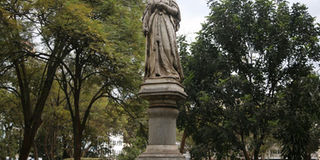Alibhai Mulla Jeevanjee: The man who built Nairobi

The statue of her late majesty Queen Victoria, empress of India at Jevanjee gardens on July 25 2013. Photo/PHOEBE OKALL
What you need to know:
- He finally settled in East Africa in 1890.
- Five years later, he was awarded a contract to supply the Imperial British East Africa Company (IBEA Co) with labour for the Kenya-Uganda Railway.
- From the proceeds of the venture, Jeevanjee expanded his construction business, eventually building most of the early post offices, government offices, and railway stations.
Although the only thing that still bears his name in Nairobi is a public park, Alibhai Mulla Jeevanjee’s story is closely interwoven with the story of Nairobi’s beginnings.
Jeevanjee was the man at the heart of the labour supply for the Uganda railway line.
Born in Karachi, Pakistan, he embarked on a career as an itinerant peddler, trekking across India and Australia, when his father died.
He finally settled in East Africa in 1890. Five years later, he was awarded a contract to supply the Imperial British East Africa Company (IBEA Co) with labour for the Kenya-Uganda Railway.
The execution of this human resource contract began almost immediately, when he facilitated the arrival of the first 350 “coolies” from the Punjab region of British-India. Within six years, Jeevanjee had supplied 31,985 workers for the railway line.
Muslims, Hindus, and Sikhs migrated to Kenya to work in different sections as carpenters, skilled labourers, electrical fitters, and metal workers.
EXPANDED BUSINESS
From the proceeds of the venture, Jeevanjee expanded his construction business, eventually building most of the early post offices, government offices, and railway stations. His investments straddled Mombasa and Nairobi.
According to some sources, Jeevanjee once owned 70 per cent of Nairobi when the city was still a sprawling township. He eventually sold much of the land and built the first buildings that housed the administrative and communication offices in the new capital.
“My grandfather built the first law courts in Nairobi, where Imenti House stands today. He also built the original Nairobi Club and was the first landlord of the museum in a building he owned next to Union Towers,” says Zarina Patel, Jeevanjee’s granddaughter. “If you trace the history of the earliest buildings in Nairobi, Jeevanjee is bound to appear somewhere as the contractor, owner, or as an investor.”
On the media front, Jeevanjee launched The African Standard in Mombasa, but sold it soon afterwards to two British businessmen who moved its operations to Nairobi. They renamed the paper The East African Standard. Today, known as The Standard, it is the oldest print newspaper in Kenya.
Now an accomplished and respected investor and entrepreneur, Jevanjee shifted his focus to politics. He was the first non-white to be appointed to the Legislative Council. He established the East African Indian National Congress, the first political party formed to champion the rights of a minority in Kenya.
The only remaining evidence that Jeevanjee once ruled the Nairobi skyline is the Jeevanjee Gardens situated between Muindi Mbingu Street and Moi Avenue. It is also bordered by Monrovia and Mokhtar Daddah streets.
The recreational gardens were built in 1904 and donated to the colonial administration in 1906. From the onset, Jeevanjee envisioned a serene recreational place in the middle of the growing city, where people could rest at any time of the day.
These wishes were respected for almost nine decades. In 1991, reports emerged that political and business interests wanted to annex the grounds and convert them into a mall and a car park. The plans were shelved following strong opposition from the Jeevanjee family and other environmentalists'.



